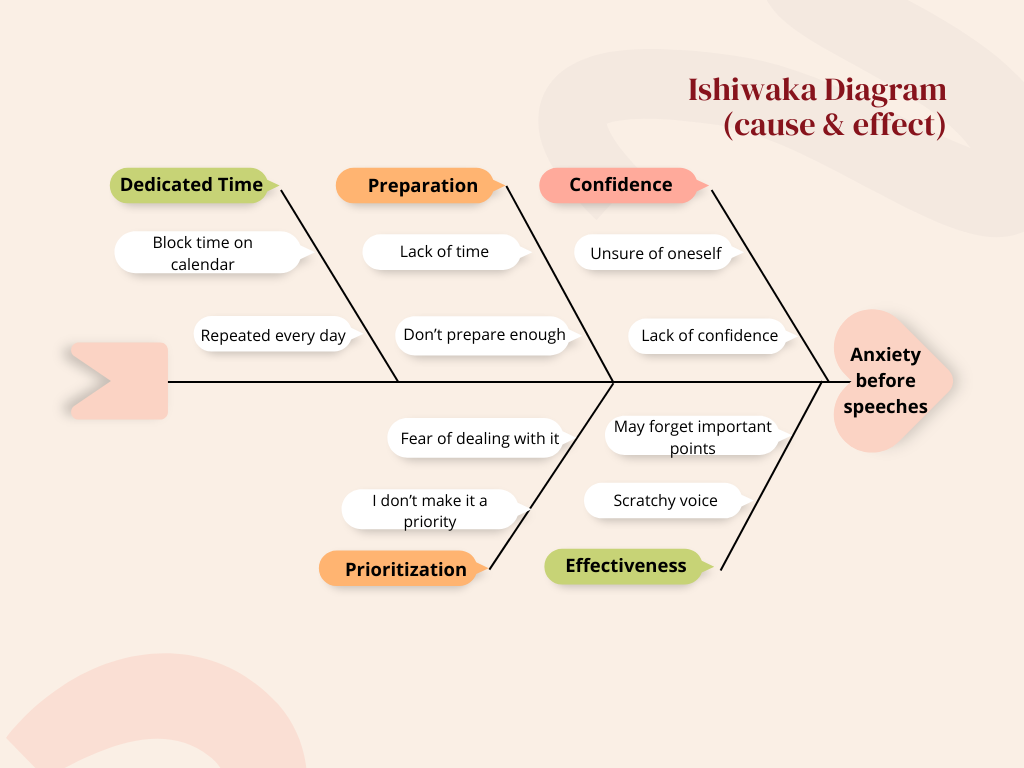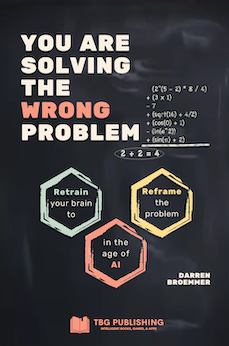From the book "You are Solving the Wrong Problem"Chapter 4: The Five Whys
Almost from the beginning, ask yourself, why am I solving this problem? This helps identify and assess the root cause, a fundamental aspect of the reframing pillar. I have to solve this particular problem because something else is a problem.
Bradley has a habit of arriving late to work. He often runs into the daily team meeting late. It is affecting his job performance. He has tried to focus on arriving on time, but it still keeps happening regularly. He decides one Saturday that he must do something about it.
The problem is simple, he arrives late to work frequently. But he asks why is that. The first reason that comes to mind is the proverbial excuse for being late, he is often caught in traffic. But stopping there will not lead to a true solution. So he asks, why does he keep hitting traffic? He leaves home too close to the start of rush hour. He goes further. Why does he leave so close to rush hour? He often sleeps through his alarm or hits snooze a few times. Why does this happen? He usually stays up too late scrolling through social media on his phone. He goes to bed at a decent time but doesn't fall asleep until hours later.
Bradley is getting closer to a root cause. He can decide not to take his phone into his bedroom, although he is concerned no one could reach him in case of an emergency. He could limit his phone time before going to sleep to 15 minutes, or some other reasonable time limit. Alternatively, he could define rules for himself and develop better screentime habits.
Or, he could keep asking why? Why does he feel the need to scroll social media for so long? What is he getting out of it? Why isn't he already tired enough to fall asleep? Does he get enough exercise? Perhaps he doesn't, and he needs to. If he took a long walk or went to the gym, he would likely sleep better and fall asleep faster.
By repeatedly asking "why" to drill down beyond surface-level symptoms, Bradley was able to uncover his late-night phone use and lack of exercise as root causes contributing to his tardiness at work. The core problems we seek to solve often originate far upstream of the surface-level issues we initially perceive. Tracing causal chains by asking "why" unpeels the onion layer by layer. This is done until the primary root cause is laid bare.
This technique for root cause analysis is called the Five Whys. It is as simple a process as you can get, but its results can be game-changing.
The mechanics of the approach
- Begin by identifying the top-level problem and write it down.
- Ask yourself why that problem occurs and note the answer.
- Evaluate whether the answer you wrote down truly identifies the root cause of the problem above. If it does not, ask yourself why again and repeat the process.
- Continue this iterative approach until you can trace the causal loop back to the initial problem.
The technique suggests that the root cause is usually reached within five iterations, hence the name. However, for complex problems, further iterations may be necessary. It could be eight iterations, or it may require only three. The point is that you don't stop until you feel confident you have reached the root cause. The main idea is to take a proactive approach and target the source of the problem. Embrace an open mind and be willing to challenge assumptions. You might uncover surprising insights along the way.
Of course, just doing the Five Whys analysis doesn't solve anything in itself – it builds understanding. You still need to design and implement solutions that address the underlying problem. It helps to differentiate between symptoms and root causes. Morning traffic was only a symptom for Bradley. Sure, it could explain the occasional late arrival, but it wasn't the real reason he was consistently late to work.
I am a big believer in this approach. If I was going to start a "Root Cause Revolution", this would be at the forefront. This process can help you unravel complex challenges and pave the way for enduring success. Five Whys is a critical item in the toolbox to use on this journey.
Why do people get anxious about public speaking
Not surprisingly, this ranks high among common fears, with well over half of adults reporting apprehension about presenting. When faced with speaking engagements, our minds and bodies often react with an anxious response. This includes an increased heart rate, negative perceptions of ourselves, a scratchy voice, and fears we will forget our important points.
What does the Five Whys technique have to say about this? Can we discover the root cause of this reaction, and craft a plan to strategically overcome this hurdle?
- Why am I anxious about presenting? A lack of preparation surfaces as a common issue. We feel unsure of ourselves when not dedicating sufficient time to practice and internalize the content. If we knew the material inside and out, that would go a long way toward alleviating the stress we feel.
- Why am I unprepared? Perhaps we didn't allocate enough dedicated prep hours. We may not have had a realistic expectation of how much time we would need to prepare. We may simply be busy, and think that we can just wing it at the last second.
- Why don’t I spend enough time preparing? We are busy, sure, but we don't make preparation a priority. People walk into our office asking questions, and this distracts us. We get pulled into meetings and don't have a block of time set aside where we can dig in and prepare. Our busyness mindset is sabotaging our success. We need to shift our priorities and be more disciplined moving forward.
- Why don't we prioritize preparing for presentations? A lack of dedicated time is the problem. It takes ten minutes or so to get into a zone. Once we are in a flow, we can organize the presentation exactly how we want it, and prepare what we are going to say for each slide. We create some personal notes with the most important points we want to make. If this is the real problem, then blocking time on our calendar for internal preparation is the solution. For some people though, they may still need to dig deeper.
- Why don't we block time on our calendar to prepare? Perhaps the anxiety of presenting subconsciously makes us not want to think about it. We don't want to experience the stress before the event even happens. Preparation makes us think about standing up at the podium in front of the audience. Now, we are at a potential root cause.
If you have anxiety about speaking in public, your root cause may be different. Your entire chain of reasoning here may likely differ, but you get the idea. Keep asking yourself questions until you feel confident you are at the core, and can't go any deeper. Then tackle that problem.
Once someone has tailored insights from an analysis like this, they can craft an action plan like blocking 2 hours every day for the two weeks leading up to a talk. This allows for plenty of time to deep dive into the content, run through the script, and get 100% comfortable with the delivery. Once the presenter feels ready, they may realize much of the anxiety stemmed from simply not taking adequate time to prepare.
I used to feel nervous at the beginning of a presentation, even when I felt prepared. However, once I got started, it felt like just talking about a subject I knew very well. That is where the preparation kicked in. Thus, in order to get past this initial hump, I would memorize verbatim the first few sentences I wanted to say. This enabled me to get started, and once the conversation was underway, everything was fine.
At the end of the day, people won't remember much about your presentation except for the main point(s). And that is only if you are lucky, or a good presenter. Be sure to highlight those points that you want the listener to take with them. They won't be thinking about whether you were a perfect orator, or spoke eloquently. They will, however, notice whether you are authentic. If you are just blowing smoke, the audience will sense that and lose interest. Being authentic is something we can control. If we prepare and focus on being ourselves, we will be fine. However, if we treat it like we are giving a State of the Union address, things may go sideways. If we approach it as presenting our research or a proposal we believe in, things will work out.
The path is not always a straight line
This technique does not have to be linear. Each level of questioning may reveal multiple answers, each with its own distinct causal chain. While the initial question may prompt an apparent cause, diving deeper often unveils a web of interconnected factors. This non-linearity reflects the complexity of real-world problems and underscores the need for a holistic understanding of the underlying causes.
I am a visual person, so I prefer to diagram things. I create a mental model by creating a visual model. Other people learn differently or prefer textual notes. However you do it, sketch out the causal chain all the way to the end.
Fishbone diagrams, also known as Ishikawa or cause-and-effect diagrams, offer a visual representation that aligns well with the Five Whys technique. The diagram resembles a fishbone, with the main problem stated at the "head" and various branches representing potential causes. Each branch can further branch out into sub-causes. This graphical representation enables individuals and teams to map out various contributing factors. It accommodates the fact that there may be more than one answer.

After you have created the diagram, keep it around. These things tend not to be static. They evolve over time. You may find out a month later that there is actually another level underneath one of the branches.
You should always be asking questions. Now let's discuss your hidden superpower. The friend that never tires of answering your questions, AI:
Chapters
2. Step out of Auto-Pilot Mode
3. Your most important skill: Asking Questions
4. Solve any problem using the Five Whys
5. AI Prompting like a Pro
6. Invention over Convention
7. How to Reframe a Problem to your Advantage
8. The Diamond Pattern: First fan-out, then fan-in
9. The Problem Paradox
10. Break free from Cognitive Bias
11. From Complex to Simple
13. Use AI for Data Analysis
14. The Curiosity Rule
15. Improve productivity by eliminating distractions
16. Optimization Problems
17. Greenfield or work within current constraints
18. Managing the most scarce resource: Time
19. Challenge yourself with Puzzles
20. Next Steps
21. Solutions to Puzzles

